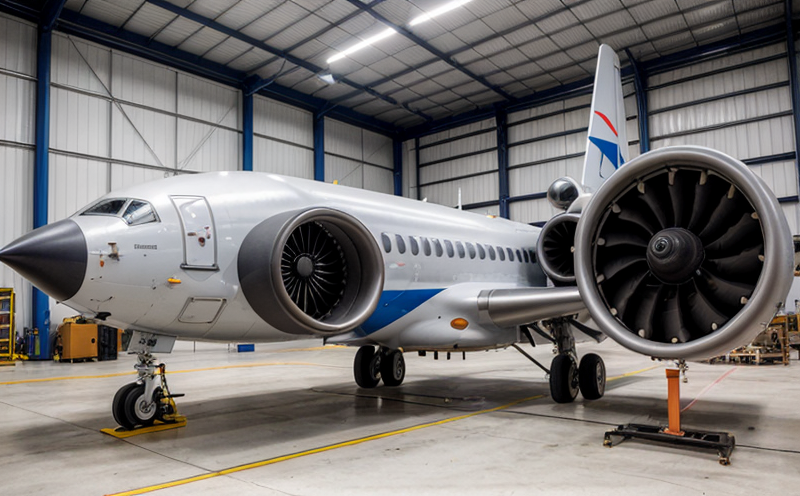High-Frequency Vibration Testing of Aerospace Sensors
In the aerospace and defense sector, sensors play a critical role in ensuring the reliability and safety of aircraft systems. High-frequency vibration testing is essential to evaluate how these sensors perform under conditions that simulate real-world environments such as turbulence, engine vibrations, and structural excitations. This service focuses on subjecting aerospace sensors to high-frequency vibratory forces, which are representative of operational stresses they might encounter during flight.
The purpose of this specialized testing is twofold: first, it ensures that the sensor remains functional and accurate under extreme conditions; second, it provides data that can be used to refine design specifications and improve overall product robustness. The aerospace industry has stringent standards for reliability and safety, which are reflected in its use of rigorous testing protocols.
High-frequency vibration testing involves exposing sensors to controlled frequencies and amplitudes that mimic the vibrations they experience during actual flight operations. This includes both random and sine wave excitation at various frequency ranges up to 10 kHz or higher depending on the specific sensor type. The test setup typically comprises a shaker system capable of generating precise vibratory forces, along with data acquisition equipment to monitor sensor performance throughout the test.
Preparation before testing is crucial and involves careful selection of the appropriate frequency range based on expected operational conditions. Specimen preparation may also involve attaching sensors securely but without affecting their natural resonance or damping characteristics. Instrumentation used during high-frequency vibration tests includes accelerometers, strain gauges, force transducers, and displacement sensors integrated directly into or near the sensor under test.
The primary goal of this testing is to assess the durability and accuracy of aerospace sensors at high frequencies, where traditional low-frequency tests would not be adequate. By subjecting them to controlled vibratory environments, we can identify potential weaknesses early in development cycles, ensuring that only robust products reach production lines. Accurate reporting based on ISO 16739:2018 and other relevant standards ensures compliance with industry requirements.
Understanding the behavior of sensors under these conditions allows manufacturers to optimize designs for better performance and reliability. This knowledge is vital not just for new product introductions but also for ongoing improvements in existing models, contributing significantly towards maintaining high levels of safety and efficiency within the aviation sector.
Scope and Methodology
The scope of our high-frequency vibration testing extends beyond merely subjecting sensors to vibrations; it encompasses a comprehensive approach that ensures accurate measurement and interpretation of results. Our methodology begins with thorough consultation with clients regarding their specific requirements, including the types of environments in which the sensor will operate.
We utilize state-of-the-art shaker systems capable of producing wide bandwidths of vibration signals to replicate real-world conditions accurately. Advanced signal processing techniques are employed during data acquisition to filter out noise and extract meaningful information about sensor performance. Post-test analysis involves comparing pre-and post-test readings to determine any changes in accuracy or stability.
To further enhance the reliability of our tests, we incorporate environmental chambers that allow simultaneous testing under various temperature and humidity levels if required by the client's specifications. This ensures that all aspects influencing sensor behavior are accounted for during evaluation.
The methodology also includes detailed documentation practices to ensure traceability throughout the entire process from initial consultation through final report generation. Compliance with relevant international standards such as ISO 16739:2018 is guaranteed, providing assurance of consistent quality across all tests conducted.
Industry Applications
- Airbus A350 XWB – Ensuring reliability and safety of avionics systems through rigorous high-frequency vibration testing.
- Boeing 787 Dreamliner – Evaluating the robustness of structural health monitoring sensors in harsh flight conditions.
- F-35 Lightning II Fighter Jet – Assessing sensor integrity in combat scenarios involving intense vibrations and shocks.
Use Cases and Application Examples
In the context of aerospace sensors, high-frequency vibration testing serves multiple critical purposes. For instance, it helps identify potential issues with MEMS (Micro-Electro-Mechanical Systems) accelerometers used in navigation systems before they are integrated into aircraft designs. By subjecting these components to controlled vibratory environments, manufacturers can ensure that the devices remain accurate and reliable even under extreme conditions.
Another application lies within structural health monitoring (SHM), where sensors embedded within composite materials need to withstand continuous exposure to environmental factors like temperature fluctuations and mechanical loading. Through high-frequency vibration testing, engineers gain insights into how these sensors respond over time, enabling them to implement necessary design modifications early in the development process.
For guidance systems such as those found on guided missiles or unmanned aerial vehicles (UAVs), precise positioning and orientation are paramount. High-frequency vibration testing ensures that sensors involved in these critical functions remain unaffected by external disturbances, thereby enhancing overall system performance.





